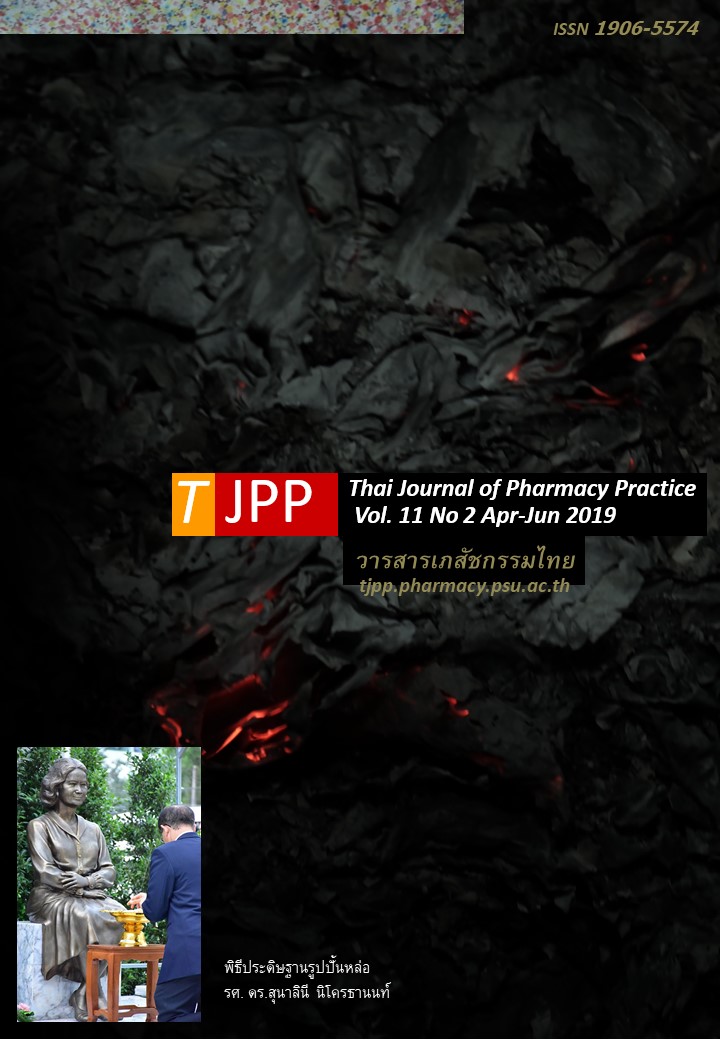การพัฒนาระบบคอมพิวเตอร์เพื่อแจ้งเตือนการแพ้ยาร่วมกับการจัดการ ฐานข้อมูลการแพ้ยาของโรงพยาบาลแห่งหนึ่งในจังหวัดสมุทรสาคร
Main Article Content
บทคัดย่อ
วัตถุประสงค์: เพื่อพัฒนาระบบแจ้งเตือนการแพ้ยาในคอมพิวเตอร์ร่วมกับแนวทางการจัดการฐานข้อมูลการแพ้ยาของโรงพยาบาล วิธีการ: การศึกษานี้เป็นงานวิจัยเชิงปฏิบัติการตามวงจรพัฒนาคุณภาพของ Deming (PDCA) จำนวน 2 วงจร วงจรละ 3 เดือน การพัฒนาออกเป็น 2 ด้าน ได้แก่ การพัฒนาระบบแจ้งเตือนการแพ้ยาในระบบ Electronic Medical Record (EMR Soft®) และการพัฒนาแนวทางการจัดการฐานข้อมูลการแพ้ยา ซึ่งประกอบด้วยแนวทางการซักประวัติการแพ้ยาสำหรับเภสัชกร และแนวทางการลงบันทึกข้อมูลประวัติการแพ้ยาในระบบคอมพิวเตอร์ แพทย์และเภสัชกรผู้ใช้งานระบบ และนักออกแบบซอฟต์แวร์ ร่วมกันพัฒนาระบบขึ้น การศึกษาประเมินผลการพัฒนาระบบจากจำนวนความคลาดเคลื่อนที่ทำให้ผู้ป่วยมีโอกาสได้รับยาที่แพ้ซ้ำ และความครบถ้วนของข้อมูลที่บันทึกในระบบระหว่างช่วงที่นำระบบไปใช้จริงระหว่างเดือนตุลาคม 2559 ถึง เมษายน 2560 หลังจบการศึกษา ผู้วิจัยประเมินความพึงพอใจของแพทย์และเภสัชกรผู้ใช้งาน ผลการวิจัย: ภายหลังการพัฒนางานร่วมกันในส่วนของการลงบันทึกข้อมูลลงในฐานข้อมูลการแพ้ยา การพัฒนาระบบแจ้งเตือนการแพ้ยา และแนวทางการจัดการฐานข้อมูลการแพ้ยา ความคลาดเคลื่อนจากการสั่งจ่ายยาที่ผู้ป่วยมีประวัติว่าแพ้ลดลงร้อยละ 35 เมื่อเทียบกับในช่วงเดือนเดียวกันของปีที่ผ่านมา ข้อมูลที่ถูกบันทึกในระบบเพิ่มมากขึ้นมากกว่าก่อนการวิจัยร้อยละ 33 ความครบถ้วนของข้อมูลครอบคลุมอาการไม่พึงประสงค์ที่เกิดขึ้นทั้งหมด หลังการพัฒนาระบบ แพทย์และเภสัชกรมีความพึงพอใจโดยรวมในระดับมาก ส่วนใหญ่ปฏิบัติตามแนวที่กำหนดไว้ สรุป: การพัฒนาระบบแจ้งเตือนการแพ้ยาโดยใช้ระบบคอมพิวเตอร์ ร่วมกับการมีแนวทางการซักประวัติการแพ้ยาและการลงบันทึกประวัติการแพ้ยาที่ชัดเจนให้กับผู้ปฏิบัติงาน ช่วยลดจำนวนความคลาดเคลื่อนที่เกิดขึ้นจากการสั่งใช้ยาที่ผู้ป่วยมีโอกาสแพ้ซ้ำ ทำให้ฐานข้อมูลการแพ้ยาของโรงพยาบาลมีความความถูกต้องและมีความน่าเชื่อถือยิ่งขึ้น สามารถนำข้อมูลไปใช้ประกอบการตัดสินใจโดยบุคลากรทางการแพทย์ในการสั่งใช้ยา จ่ายยา และบริหารยาให้กับผู้ป่วยได้อย่างปลอดภัย
Article Details
ผลการวิจัยและความคิดเห็นที่ปรากฏในบทความถือเป็นความคิดเห็นและอยู่ในความรับผิดชอบของผู้นิพนธ์ มิใช่ความเห็นหรือความรับผิดชอบของกองบรรณาธิการ หรือคณะเภสัชศาสตร์ มหาวิทยาลัยสงขลานครินทร์ ทั้งนี้ไม่รวมความผิดพลาดอันเกิดจากการพิมพ์ บทความที่ได้รับการเผยแพร่โดยวารสารเภสัชกรรมไทยถือเป็นสิทธิ์ของวารสารฯ
เอกสารอ้างอิง
2. Ningsanon T, Yothapital C. Adverse drug reaction. 3rd ed. Bangkok: Pauramutha Karn Pim; 2007.
3. Ningsanon T. Prevention of medication error. In: Chulavatnatol S, Montalantikul P, editors. Drug administration. Bangkok: Piccani; 2009. p. 8-25.
4. Kimberly G, Miguel A and Eric M. Redesigning the allergy module of the electronic health record. Ann Allergy Asthma Immunol. 2016; 117: 126-31.
5. Teryl K, Crytal S, Sally C and Steven M. The effectiveness of computerized order entry at reducing preventable adverse drug event and medication errors in hospital settings: a systematic review and meta-analysis. Syst Rev 2014; 3: 56. doi: 10.1186/2046-4053-3-56.
6. Kidkeukarun R, Taharn T, Tovaranonte S, Champu not P, Tienchairoj A, Ketsamma K, et al. Results of repeated drug allergy surveillance system develop ment Buddhachinaraj Phitsanulok Hospital. Buddha chinaraj Medical Journal 2008; 3: 852-61.
7. Maxin T, Diane L, Sarah P, Foster G, Kenneth L, Paige G, et al. Rising drug allergy alert overrides in electronic health records: an observational retro spective study of a decade of experience. J Am Med Inform Assoc. 2016; 23: 601-8.
8. Fernando B, Morrison Z, Kalra D, Cresswell K, Sheikh A. Approaches to recording drug allergies in electro nic health records: qualitative study. PLoS One 2014; 9: e93047. doi: 10.1371/journal.pone.009347.
9. Christopher B, Candy T, David Q, Vicki J, Eunice T, Joseph G. Impact of pharmacist-driven protocol to improve drug allergy documentation at University Hospital. Hosp Pharm 2013; 48: 302-7.
10. National Institute for Health and Card Excellence (NICE). Drug allergy: diagnosis and management of drug allergy in adults, children and young people [online]. 2014 [cited Dec 9, 2017]. Available from: www.ncbi.nlm.nih.gov/pubmedhealth/PMH0068956/
11. Wiboonsirikul K. Development of repeated drug allergy prevention system in health promotion hospital network of Bang Pahan district, Phra Nakhon Si Ayutthaya province by evaluating the accuracy of patient drug allergic history. Journal of Preventive Medicine Association of Thailand 2015; 3: 245-61.
12. Pitakum C. Study of self-reported of drug allergy history at a university hospital. Journal of North Thailand Pharmaceutical Society 2017; 1: 16-20.
13. Mattij S, Hanneke W, Drewes and Ferry K. Use of electronic medical records and quality of patient data: different reaction patterns of doctors and nurses to the hospital organization. BMC Med Inform Decis Mak 2017; 17:17. doi: 10.1186/s12911-017-0 412-x.
14. Sriudorn P, Chaichalermpong W. System develop ment to prevent repeated drug allergy in Roi Et province by linking drug allergy data through the HOSxP system [online]. 2017 [cited Dec 7, 2017]. Available from: https://gsbooks.gs.kku.ac.th/60/nigrc 2017/pdf/ MMP11.pdf.
15. Srithunyarat T, Boonthawee B, Deepetch N. Repeated drug allergy prevention system in Yaso thon hospital. Medicinal and Health Product Bulletin. 2014; 17: 48-52.
16. Zhou L, Dhopeshwarkar N, Blumenthal KG, Goss F, Topaz M, Slight SP, et al. Drug allergy docu- mented in electronic health records of a large healthcare system. Clin Transl Allergy 2016; 71: 13 05-13.
17. Tyken C, Gilad J, Tonushree J and Paticia H. Characteristics and consequences of drug allergy alert overrides in a computerized physician order- entry system. J Am Med Inform Assoc 2004; 11: 482 -91.


